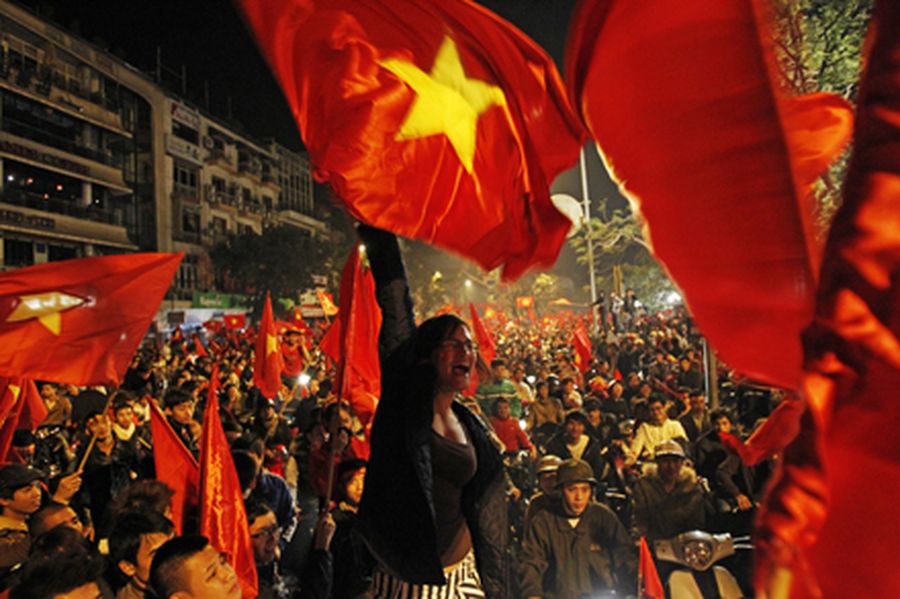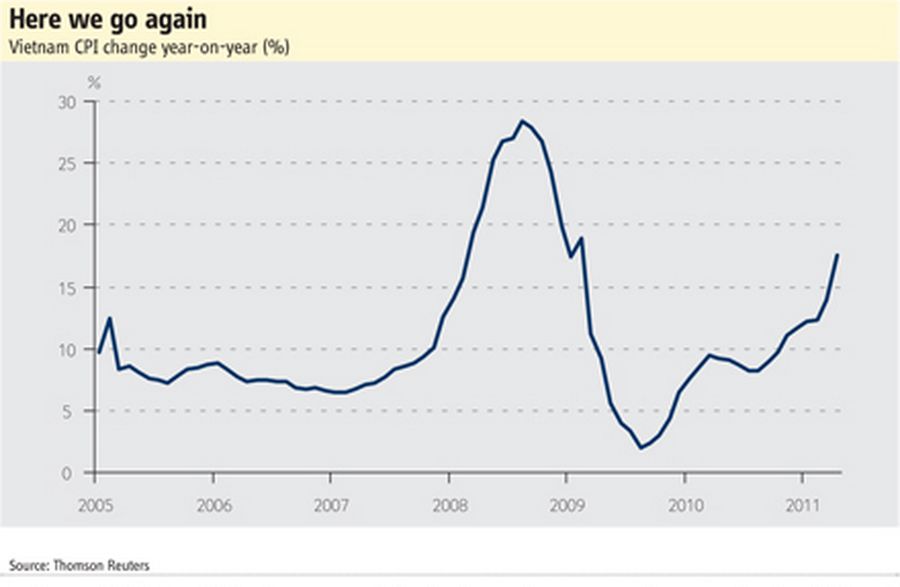Fast-growing Vietnam, host of this year’s ADB annual meeting, remains one of the region’s most unpredictable economies. While analysts believe in the country’s long-term prospects, some immediate challenges still need to be overcome.
The World Bank recently elevated Vietnam to lower middle-income status after finding its gross national income reached US$1,000 per head in 2009, boosting confidence in the country’s prospects. Economists expect the country to continue to enjoy high growth, with HSBC’s predictions calling for an expansion of 6.8% for 2011, flat to last year’s level.
With high growth, however, come high risks.
“The risks of financial instability leading to a sharp deterioration of sovereign creditworthiness in an abrupt economic slowdown remain significant,” warned Standard & Poor’s primary credit analyst Kim Eng Tan in April. “It’s too early to conclude that the economic situation is stabilising or even improving; the outcome depends on policymakers’ ability to deliver on their promises.”

Source: Reuters/Nguyen Huy Kham
Vietnamese soccer fans gather on the street to celebrate their victory over Singapore in 2010.
Kunio Senga, director general of the ADB’s South-East Asia department, sums up the challenge facing Vietnam: “Because the country is expanding so rapidly, the question is whether it has the capacity to absorb this growth in a sustainable manner.”
There are many reasons to be concerned. The inflation that plagued Vietnam in 2008, when prices went up an average of 23% over the year, has resurfaced. By March, inflation was running at 13.9% a year, while indications of an April figure closer 17.5% will do little to reassure economists that the country has the situation under control.
Policy confusion
The ADB expects inflation to average 13.3% in 2011, peaking in the third quarter, according to the latest Asian Development Outlook report, published in early April. A combination of fast economic growth and rampant domestic demand are driving up inflation, with the ADB predicting the economy will expand by 6.1% this year - slightly lower than in 2010 as a result of the country’s inflation-tackling policies.
The Vietnamese Government has committed to a series of measures to combat inflation, but confidence in its policy took a knock in early February when it devalued the official dong rate by 8.5% against the US dollar - a seemingly contradictory depreciation that instead increased inflationary pressure. It took until February 24 for the government to release a set of measures to restore macroeconomic stability, leaving many observers to point to the two-week delay as a sign of policy confusion.
Resolution 11 eventually introduced a number of notably tighter monetary policies, including limiting credit growth and reducing foreign currency use in an effort to stabilise the dong. It also promised to raise electricity and fuel prices to encourage capacity investments, while pledging more transparency in policy direction.
“The lack of timely and adequate information is always a problem,” said Senga. “We now have to monitor closely if these policies will restore macro stability. We are confident, but the implementation of these measures in a transparent manner will be key.”
Transparency and bureaucracy have become perennial concerns in Vietnam. Administrative procedures and systems are notoriously cumbersome, decision-making is very slow and often not transparent. The lack of co-ordination extends to the upper echelons of government, with the ADB noting a lack of inter-ministerial co-ordination, delegation and accountability. Investment approvals often require the involvement of multiple ministries and regulatory agencies, eventually requiring the prime minister to step in to make a final decision if the state’s multiple organs fail to decide between them.
Governance concerns abound in the country’s state-owned enterprises, especially after the public shaming of Vinashin, the shipbuilder that had expanded into a sprawl of other industries. When the government said in July 2010 the company would be restructured after being pushed “to the brink of bankruptcy” after years of expansion and false accounting, foreign investors began reassessing their dealings with other SOEs. The government’s refusal to stand behind a letter of comfort led to Vinashin’s default on a US$60m instalment due on a US$600m international loan in December, triggering a downgrade to the sovereign’s credit rating by Moody’s. Standard & Poor’s quickly followed suit, cutting the country’s foreign currency rating from BB to BB-.
Senga, however, sees the government intervention in a more positive light.
“The political leaders admitted there was oversight on the government’s part. They criticised themselves and promised to avoid similar situations, rather than just putting a lid on it,” he said. “I think it sent a good message. Yes, it was an unfortunate event, but it set the perspective in the medium to long term that economic reform should continue.”
Mega projects
The Vinashin saga has not deterred the ADB from lending to the country. The ADB’s Vietnam programme is likely to exceed US$1bn in 2011, having increased sharply since 2005-06. Much of that will be dedicated to landmark projects, such as the Hanoi metro.
The ADB’s board approved a loan for the development of the Hanoi metro at the end of March, pledging US$293m to support a US$1bn project. European development agencies, including Germany’s GDZ, were among the co-financing partners.
That approval followed a US$540m multi-tranche financing to support the construction of a metro line in Ho Chi Minh City, Vietnam’s largest and most densely populated city. Ho Chi Minh’s 9m population is expected to swell to 14m by 2025, according to ADB estimates, putting pressure on an already overloaded road traffic system. Private sector involvement has yet to materialise, but officials hope that will follow in future phases once a track record is established and a comprehensive framework for private sector involvement is in place.
“Mega projects like this are important for economic growth, but they also attract the private sector, help the environment and can introduce best practices to the country’s SOEs. The soft elements also need to be brought to the front, and that is very helpful in a medium- to long-term basis,” said Senga.

Senga says the ADB’s support is targeted at addressing Vietnam’s medium- and long-term development challenges, including poor infrastructure and a lack of qualified human resources: a higher education project is also before the board.
Capacity-building efforts focus on creating a legal and regulatory framework that will encourage private sector investors to Vietnam’s infrastructure sector through public-private partnerships.
“Under every project, we have a soft component, essentially to address capacity support and to bring an element of commercial operation. In that context, we are launching a comprehensive programme of assistance in PPP,” said Senga. “We are still finalising the proposal, together with a large number of other development partners, but it will be quite comprehensive, starting with legislation to improve the environment to bring private sector support and set up funds to identify and structure the financing package for individual proposals.”
Efforts to promote the PPP concept to Vietnamese policymakers appear to be paying off. Vice minister of planning and investment Dang Huy Dong told reporters at the end of March that PPP was in “pilot implementation”, stressing that foreign and domestic investors would be welcome to participate.
However, Vietnam’s elevation to middle-income status - while positive for the region’s development - brings with it new fears. Kenichi Ohno at the Vietnam Development Forum has repeatedly warned the economy could fall into the “middle-income trap” - where it fails to find a competitive advantage to allow it to transition to a higher-income economy.
Senga is well aware of the challenges ahead, but he emphasises the ADB’s commitment to supporting the country’s continued development, if necessary, through additional financial support.
“The willingness of the ADB to increase its level of support is there. The country has some immediate challenges in addressing macroeconomic stability, but, in the medium and long term, we are very positive.”

